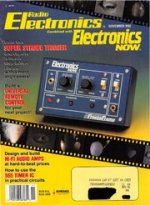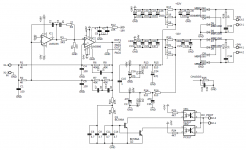While looking for completely different things, I found this old magazine by chance from November 1992
Radio Electronics (November 1992) : Free Download, Borrow, and Streaming : Internet Archive
and an excellent diy power amp project at hard to beat price with LM1875 and AD711 - go to the attached PDF file.
Are there more advanced versions in this topology with operational amplifier IC's from last generation like TI's OPA1611 or OPA1656 - go to
Burr-Brown OPA1611/1612 are here
together with traditional power amp ICs like LM3886 or TDA7293/TDA7294 ?
I am mainly interested in finished amplifier devices (both vintage for easy upgrade and newer versions) but also in diy projects.
Best thanks for an advice and threads here on diyaudio.
Check in this case also this URLs:
ESP SIM (Sound Impairment Monitor)
https://www.nanovolt.ch/resources/ic_opamps/pdf/opamp_distortion.pdf
Choosing of best sounding OP AMPs for the lowest possible THD+N -really the best Way?
Low-distortion Audio-range Oscillator
(page 960, post #9596)
Radio Electronics (November 1992) : Free Download, Borrow, and Streaming : Internet Archive
and an excellent diy power amp project at hard to beat price with LM1875 and AD711 - go to the attached PDF file.
Are there more advanced versions in this topology with operational amplifier IC's from last generation like TI's OPA1611 or OPA1656 - go to
Burr-Brown OPA1611/1612 are here
together with traditional power amp ICs like LM3886 or TDA7293/TDA7294 ?
I am mainly interested in finished amplifier devices (both vintage for easy upgrade and newer versions) but also in diy projects.
Best thanks for an advice and threads here on diyaudio.
Check in this case also this URLs:
ESP SIM (Sound Impairment Monitor)
https://www.nanovolt.ch/resources/ic_opamps/pdf/opamp_distortion.pdf
Choosing of best sounding OP AMPs for the lowest possible THD+N -really the best Way?
Low-distortion Audio-range Oscillator
(page 960, post #9596)
Attachments
Last edited:
That article was one of my many sources of inspiration for the Modulus-86. I have looked at using the OPA1611 in a composite amp with the LM3886, but the phase wobble from the internal compensation in the OPA1611 makes that rather difficult. The wobble falls in the 1-10 MHz region which is where the LM3886 starts to get wonky too. Last I looked at it I wasn't able to find a solution I trusted enough to publish it. Not thereby said that finding a solution is impossible. 🙂 I use the LME49720 in the Modulus-86 and it works very well.
Tom
Tom
You will find that there are quite a few composites around; mostly with the LM3886. Not anywhere near well engineered as the Modulus but obviously working. Also look at the long thread about LM1875 composites started by FauxFrench. Lots of information to be found.
We have started a project with the TDA7293 and will eventually try the OPA1656, OPA1612, LM4652 in it because that´s what we have around:
Open source layout for a TDA7293 composite amp
Please note that the schematic is not the most recent one which has many more compensation networks.
We received a first revision of the PCB but I´d guess it can take a couple of weeks before we actually build up some channels, evaluate and measure.
We have started a project with the TDA7293 and will eventually try the OPA1656, OPA1612, LM4652 in it because that´s what we have around:
Open source layout for a TDA7293 composite amp
Please note that the schematic is not the most recent one which has many more compensation networks.
We received a first revision of the PCB but I´d guess it can take a couple of weeks before we actually build up some channels, evaluate and measure.
Last edited:
SMPS powered small cl. A amp
I very much like this example of a composite.
With the current buffer output stage it should simplify design very much.
Often chosen for headphone amplifiers (built one and loved it) it could also be used with speakers when using a OPA454 as controlling opamp for increased voltage swing.
Obviously all these suggestions aren´t finished amplifier modules...
Maybe Tom can offer you a discount if you buy many modules ;-)
I very much like this example of a composite.
With the current buffer output stage it should simplify design very much.
Often chosen for headphone amplifiers (built one and loved it) it could also be used with speakers when using a OPA454 as controlling opamp for increased voltage swing.
Obviously all these suggestions aren´t finished amplifier modules...
Maybe Tom can offer you a discount if you buy many modules ;-)
> SMPS powered small cl. A amp
> I very much like this example of a composite.
This is just an opamp driving a Class-A complementary-source-follower buffer.
It does not have the problem of 2 opamps in cascade, and then their resulting stability problems.
Not that they cannot be solved.
Here is another example :
The XEN XELF Headphone Buffer
We have used it to drive 3R load with low distortion :
Distortion Measurements of a MOSFET Relay for Loudspeaker Protection
Patrick
> I very much like this example of a composite.
This is just an opamp driving a Class-A complementary-source-follower buffer.
It does not have the problem of 2 opamps in cascade, and then their resulting stability problems.
Not that they cannot be solved.
Here is another example :
The XEN XELF Headphone Buffer
We have used it to drive 3R load with low distortion :
Distortion Measurements of a MOSFET Relay for Loudspeaker Protection
Patrick
Do you know the URL ?You will find that there are quite a few composites around; mostly with the LM3886. Not anywhere near well engineered as the Modulus but obviously working. Also look at the long thread about LM1875 composites started by FauxFrench. Lots of information to be found.
In this URL is mentioned (post #3) this very interesting project:You will find that there are quite a few composites around; mostly with the LM3886. Not anywhere near well engineered as the Modulus but obviously working. Also look at the long thread about LM1875 composites started by FauxFrench. Lots of information to be found.
We have started a project with the TDA7293 and will eventually try the OPA1656, OPA1612, LM4652 in it because that´s what we have around:
Open source layout for a TDA7293 composite amp
Please note that the schematic is not the most recent one which has many more compensation networks.
We received a first revision of the PCB but I´d guess it can take a couple of weeks before we actually build up some channels, evaluate and measure.
????????? ???????? ZD-50
https://www.pcbway.com/project/member/?bmbno=E1B5CBB5-E662-47
Unfortunately I haven't time to realize such diy projects and therefore I want to know commercial available amplifiers where this topology is in use.
BTW - there are a lot of threads to this topology, because there are exist a lot of different namings for the same topology.
https://www.analog.com/media/en/technical-documentation/application-notes/an21f.pdf
LM1875 in parallel configuration and used in a composite amplifier.
Attachments
Last edited:
Btw it would be Scott Wurcer
I understand the OP's slip, my father changed it during WWII (he was a B17 bombardier) for obvious reasons.
Finished modules or a finished amplifier incl. case etc.?Unfortunately I haven't time to realize such diy projects and therefore I want to know commercial available amplifiers where this topology is in use.
The Modulus series are the only I know of although quite a few commercially available amplifiers fall under the category "nested feedback" or "composite".
Discrete examples you can find some here:
What is nested feedback, how it realy works and some examples...
Do you know the URL ?
Probably this one: LM1875 in parallel configuration and used in a composite amplifier.
There are a few other composite LM3886/LM1875 amps around:
composite amplifiers
LM3886++ Simplest Composite Amp
Composite amplifier: LM3886 + LME49710
And naturally MyRef and Modulus-86.
Tom
Thank you. That "NDFL" and "turbo-charged" resp. "composite" is the same approach is new to me.Finished modules or a finished amplifier incl. case etc.?
The Modulus series are the only I know of although quite a few commercially available amplifiers fall under the category "nested feedback" or "composite".
Discrete examples you can find some here:
What is nested feedback, how it really works and some examples...
Cherry's NDFL was realized in Pioneer's integrated amps A5 and A7 - go to
New Cherry NDFL amp
this thread I discover additional:
Low distortion current driven Class-B output stage
Post #95 under
Review and Measurements of Purifi 1ET400A Amplifier | Page 5 | Audio Science Review (ASR) Forum
and post #1 under
Tear down of Neurochrome HP-1 High Perf Headphone Amp | Audio Science Review (ASR) Forum
shows the simplified schematic of the Modulus series.
But what is the naming of DENON's approach in post #2 under
Denon PMA-900V lowering gain/opamp swap
and post #17-19 under
about the Denon PMA-700 amp
so as post #4080 under
Bob Cordell Interview: Error Correction
Last edited:
What about this approach for an power amplifier ?
Samuel Groner's super opamp
Analog Circuit Design · Samuel Groner · Publications
Samuel Groner's super opamp
Analog Circuit Design · Samuel Groner · Publications
Attachments
- Home
- Amplifiers
- Chip Amps
- Modern Version of Scott Wurzer's turbocharged Power Amplifier with TI's OPA1611 ?

